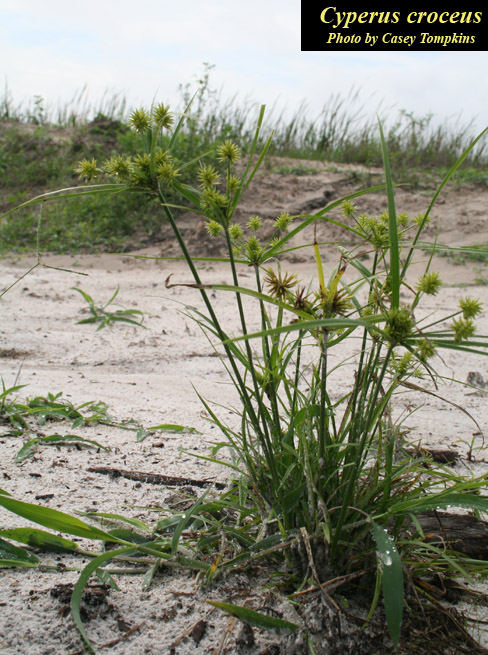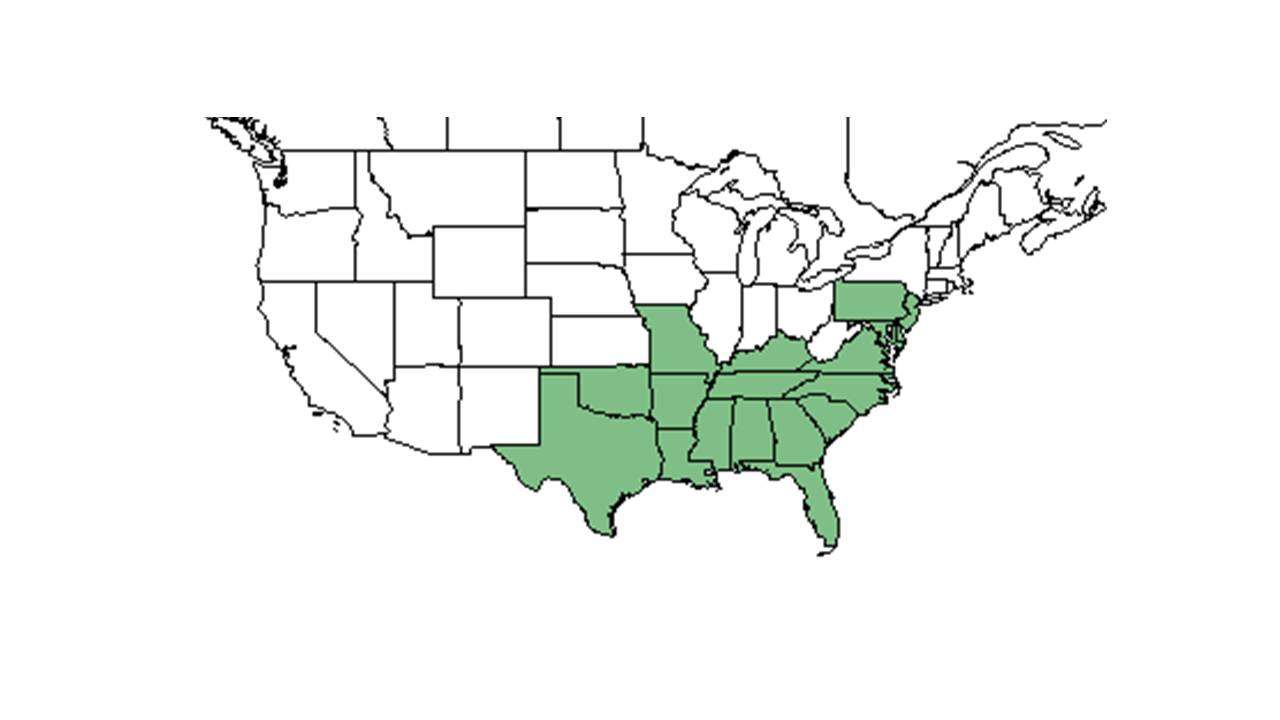Difference between revisions of "Cyperus croceus"
KatieMccoy (talk | contribs) |
(→Taxonomic notes) |
||
| (15 intermediate revisions by 10 users not shown) | |||
| Line 8: | Line 8: | ||
| divisio = Magnoliophyta - Flowering plants | | divisio = Magnoliophyta - Flowering plants | ||
| classis = Liliopsida – Monocotyledons | | classis = Liliopsida – Monocotyledons | ||
| − | | ordo = | + | | ordo = Poales |
| familia = Cyperaceae | | familia = Cyperaceae | ||
| genus = ''Cyperus'' | | genus = ''Cyperus'' | ||
| Line 20: | Line 20: | ||
Common name: Baldwin's flatsedge | Common name: Baldwin's flatsedge | ||
==Taxonomic notes== | ==Taxonomic notes== | ||
| − | Synonyms: ''Cyperus globosus''; ''C. multiflorus'' (Britton) Small | + | Synonyms: ''Cyperus globulosus'' Aublet<ref name=weakley>Weakley, A.S. 2020. Flora of the Southeastern United States. Edition of 20 October 2020. University of North Carolina at Chapel Hill, Chapel Hill, North Carolina.</ref> |
| + | |||
| + | Varieties: ''Cyperus globosus''; ''C. multiflorus'' (Britton) Small; ''C. retrorsus'' Chapman var. ''robustus'' (Böckler) Kükenthal; ''C. plankii'' Britton<ref name=weakley/> | ||
| + | |||
==Description== | ==Description== | ||
<!-- Basic life history facts such as annual/perrenial, monoecious/dioecious, root morphology, seed type, etc. --> | <!-- Basic life history facts such as annual/perrenial, monoecious/dioecious, root morphology, seed type, etc. --> | ||
| Line 30: | Line 33: | ||
It is one of the first plants to appear after clear-cutting; it can appear within three years.<ref name="Archer et al 2007"/> | It is one of the first plants to appear after clear-cutting; it can appear within three years.<ref name="Archer et al 2007"/> | ||
===Habitat=== <!--Natural communities, human disturbed habitats, topography, hydrology, soils, light, fire regime requirements for removal of competition, etc.--> | ===Habitat=== <!--Natural communities, human disturbed habitats, topography, hydrology, soils, light, fire regime requirements for removal of competition, etc.--> | ||
| − | ''Cyperus croceus'' requires a semi-tropical climate and can dwell in temperatures from -1 to 37 degrees Celsius. It prefers moist areas, including fluvial environments and floodplains, but can occur in a range of soils, from sand, to sandy peat, loam, and drying loamy sand<ref name=fsu></ref> | + | ''Cyperus croceus'' requires a semi-tropical climate and can dwell in temperatures from -1 to 37 degrees Celsius. It prefers moist areas, including fluvial environments and floodplains, but can occur in a range of soils, from sand, to sandy peat, loam, and drying loamy sand.<ref name=fsu></ref> |
| − | It can be found in mixed-pine forests,<ref name="Archer et al 2007">Archer, J. K., D. L. Miller, et al. (2007). "Changes in understory vegetation and soil characteristics following silvicultural activities in a southeastern mixed pine forest." Journal of the Torrey Botanical Society 134: 489-504.</ref> upland hardwood forests, swampy woodlands, and dry ponds. It can also occur in disturbed habitat such as roadsides, citrus groves, spoil banks, and pastures<ref name=fsu/> | + | It can be found in mixed-pine forests,<ref name="Archer et al 2007">Archer, J. K., D. L. Miller, et al. (2007). "Changes in understory vegetation and soil characteristics following silvicultural activities in a southeastern mixed pine forest." Journal of the Torrey Botanical Society 134: 489-504.</ref> upland hardwood forests, swampy woodlands, and dry ponds. It can also occur in disturbed habitat such as roadsides, citrus groves, spoil banks, and pastures.<ref name=fsu/> |
| − | Associated species includes ''Alternanthera, Carex, Cephalanthus, Polygonum''<ref name=fsu/> | + | Associated species includes ''Alternanthera, Carex, Cephalanthus, Polygonum.''<ref name=fsu/> |
===Phenology=== <!--Timing off flowering, fruiting, seed dispersal, and environmental triggers. Cite PanFlora website if appropriate: http://www.gilnelson.com/PanFlora/ --> | ===Phenology=== <!--Timing off flowering, fruiting, seed dispersal, and environmental triggers. Cite PanFlora website if appropriate: http://www.gilnelson.com/PanFlora/ --> | ||
| − | ''C. croceus'' has been observed flowering and fruiting in May through November<ref name=fsu/> | + | ''C. croceus'' has been observed flowering and fruiting in May through November with peak inflorerscence in August.<ref>Nelson, G. [http://www.gilnelson.com/ PanFlora]: Plant data for the eastern United States with emphasis on the Southeastern Coastal Plains, Florida, and the Florida Panhandle. www.gilnelson.com/PanFlora/ Accessed: 8 DEC 2016</ref><ref name=fsu/> |
| − | |||
<!--===Seed dispersal===--> | <!--===Seed dispersal===--> | ||
<!--===Seed bank and germination===--> | <!--===Seed bank and germination===--> | ||
===Fire ecology=== <!--Fire tolerance, fire dependence, adaptive fire responses--> | ===Fire ecology=== <!--Fire tolerance, fire dependence, adaptive fire responses--> | ||
| − | It is fire tolerant<ref name=fsu/> | + | It is fire tolerant.<ref name=fsu>Florida State University Robert K. Godfrey Herbarium database. URL: http://herbarium.bio.fsu.edu. Last accessed: June 2014. Collectors: Loran C. Anderson, Richard Carter, Angus Gholson, Robert K. Godfrey, N. C. Henderson, M. Kral, R. Kral, H. Kurz, S. W. Leonard, J. B. McFarlin, Richard S. Mitchell, P. L. Redfearn, Paul O. Schallert, H. L. Blomquist, William R. Stimson, R. A. Norris, K. E. Blum, Ed Keppner, and Lisa Keppner. States and Counties: Florida: Calhoun, Columbia, Dade, Dixie, Escambia, Franklin, Hernando, Highlands, Indian River, Jackson, Jefferson, Lamar, Leon, Liberty, Martin, Okaloosa, Orange, Palm Beach, Pasco, Santa Rosa, Seminole, St. Lucie, Sumter, Wakulla, and Walton. Georgia: Clinch</ref> |
<!--===Pollination===--> | <!--===Pollination===--> | ||
| − | <!--=== | + | <!--===Herbivory and toxicology===--> |
<!--===Diseases and parasites===--> | <!--===Diseases and parasites===--> | ||
| − | ==Conservation and | + | ==Conservation, cultivation, and restoration== |
| − | == | + | |
| + | ==Cultural use== | ||
==Photo Gallery== | ==Photo Gallery== | ||
<gallery widths=180px> | <gallery widths=180px> | ||
| Line 55: | Line 58: | ||
==References and notes== | ==References and notes== | ||
| − | |||
Latest revision as of 18:46, 23 May 2023
| Cyperus croceus | |
|---|---|

| |
| Photo by Casey Tompkins, Atlas of Florida Vascular Plants | |
| Scientific classification | |
| Kingdom: | Plantae |
| Division: | Magnoliophyta - Flowering plants |
| Class: | Liliopsida – Monocotyledons |
| Order: | Poales |
| Family: | Cyperaceae |
| Genus: | Cyperus |
| Species: | C. croceus |
| Binomial name | |
| Cyperus croceus Vahl | |

| |
| Natural range of Cyperus croceus from USDA NRCS Plants Database. | |
Common name: Baldwin's flatsedge
Contents
Taxonomic notes
Synonyms: Cyperus globulosus Aublet[1]
Varieties: Cyperus globosus; C. multiflorus (Britton) Small; C. retrorsus Chapman var. robustus (Böckler) Kükenthal; C. plankii Britton[1]
Description
A description of Cyperus croceus is provided in The Flora of North America. This species is a perennial graminoid.
Distribution
Ecology
It is one of the first plants to appear after clear-cutting; it can appear within three years.[2]
Habitat
Cyperus croceus requires a semi-tropical climate and can dwell in temperatures from -1 to 37 degrees Celsius. It prefers moist areas, including fluvial environments and floodplains, but can occur in a range of soils, from sand, to sandy peat, loam, and drying loamy sand.[3]
It can be found in mixed-pine forests,[2] upland hardwood forests, swampy woodlands, and dry ponds. It can also occur in disturbed habitat such as roadsides, citrus groves, spoil banks, and pastures.[3]
Associated species includes Alternanthera, Carex, Cephalanthus, Polygonum.[3]
Phenology
C. croceus has been observed flowering and fruiting in May through November with peak inflorerscence in August.[4][3]
Fire ecology
It is fire tolerant.[3]
Conservation, cultivation, and restoration
Cultural use
Photo Gallery
References and notes
- ↑ 1.0 1.1 Weakley, A.S. 2020. Flora of the Southeastern United States. Edition of 20 October 2020. University of North Carolina at Chapel Hill, Chapel Hill, North Carolina.
- ↑ 2.0 2.1 Archer, J. K., D. L. Miller, et al. (2007). "Changes in understory vegetation and soil characteristics following silvicultural activities in a southeastern mixed pine forest." Journal of the Torrey Botanical Society 134: 489-504.
- ↑ 3.0 3.1 3.2 3.3 3.4 Florida State University Robert K. Godfrey Herbarium database. URL: http://herbarium.bio.fsu.edu. Last accessed: June 2014. Collectors: Loran C. Anderson, Richard Carter, Angus Gholson, Robert K. Godfrey, N. C. Henderson, M. Kral, R. Kral, H. Kurz, S. W. Leonard, J. B. McFarlin, Richard S. Mitchell, P. L. Redfearn, Paul O. Schallert, H. L. Blomquist, William R. Stimson, R. A. Norris, K. E. Blum, Ed Keppner, and Lisa Keppner. States and Counties: Florida: Calhoun, Columbia, Dade, Dixie, Escambia, Franklin, Hernando, Highlands, Indian River, Jackson, Jefferson, Lamar, Leon, Liberty, Martin, Okaloosa, Orange, Palm Beach, Pasco, Santa Rosa, Seminole, St. Lucie, Sumter, Wakulla, and Walton. Georgia: Clinch
- ↑ Nelson, G. PanFlora: Plant data for the eastern United States with emphasis on the Southeastern Coastal Plains, Florida, and the Florida Panhandle. www.gilnelson.com/PanFlora/ Accessed: 8 DEC 2016